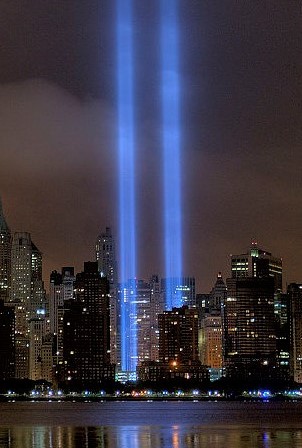The events of 9/11 remind us that outside attacks have always brought Americans together.
-
November/December 2001
Volume52Issue8

September 11, 2001. A new date to remember, unlike any other in our history. The last significant attack on the mainland United States by an outside enemy occurred in the War of 1812, almost two centuries ago. The only American death tolls that compare with those in New York came during the Civil War, and now the number who died in Manhattan alone—leaving aside the deaths in Washington and Pennsylvania—may exceed the 6,000 killed at the Battle of Antietam, which was previously the most deadly day in American history.
Even those in the midst of the disaster were caught unawares by the singularity of the event. A young trader trapped in the World Trade Center telephoned his father, a retired fireman, to ask what he should do to escape the flames; the reply was “Go to the roof.” Fire is a danger we know from centuries of experience. But who could recall a skyscraper of more than 100 stories crumbling to the ground? “This is not possible,” a stunned witness said as the building sank in a cloud of dust; nothing in our past prepared us for the possibility.
Outside attacks have always brought Americans together. Pearl Harbor immediately comes to mind, but the British assault at Lexington, Massachusetts, on April 19, 1775, is another example. John Hancock was terrified as he fled the battle scene and began a long trip to Philadelphia, where the Second Continental Congress would have its first session on the tenth of May. He feared that the other colonies would blame Massachusetts for starting an unwelcome war and leave it to face British reprisals alone. But as the news spread through the country “on the wings of the wind"—taking only days to reach New York—colonists along the Massachusetts delegates’ route came out to express their sympathy and support.
Finally, after receiving an unprecedented reception in New York, Hancock and his colleagues entered Philadelphia in what can only be called a triumphal procession with “bells all ringing, and the air rent with Shouts and huzza’s.” Never before, Virginia’s Richard Henry Lee reported, had there been “more perfect unanimity among any sett of Men than among the Delegates,” and “all the old Provinces not one excepted are directed by the same firmness of union, and determination to resist by all ways and to every extremity.” The Second Continental Congress soon became, for all practical purposes, the first government of the United States. Americans joined arms and became a nation in the wake of an outside attack. Good of an unpredictable sort can come out of evil.
Events assume historical importance not only by their consequences but for what they reveal about the time and place at which they happened. Notice the identities of the people who are missing or dead at the World Trade Center. Hundreds were foreign nationals, and the Americans who lost their lives bore names that suggest the far-flung origins of their families. There were Irish and Italians beside Latin Americans, Indians and other Asians, Jews and also Arabs. Some were recent immigrants, others American-born of parents who came here for the opportunities that many of their children found in the World Trade Center. New York, like the nation of which it is now more than ever an indisputable part, is an amalgam of peoples. The terrorists attacked symbols of American financial and military strength, but they killed people, including many of their own.
What can we learn from the past to assuage our sorrow? Grief is immediate for those whose friends or family members died, and they will carry the scars to their graves. Some have the consolation, unthinkable at Antietam, Gettysburg, or even Pearl Harbor, of a final “goodbye” and “I love you” from a cell phone, a device that added to the singularity of September 11, 2001. And there are mourners who know exactly how heroically their loved ones died: Airplane passengers, having learned by cell phone about the earlier crashes, brought the fourth flight down not in a fiery collision with another populated landmark but in rural Pennsylvania, dying in a way that let others live.
For the rest of us, the pain is an imaginative extension of what we have known privately, multiplied until the burden is indeed, as Mayor Rudolph Giuliani predicted, more than we can bear. The desperate notices for missing persons posted in New York, with pictures of smiling people like so many we know and unforgettable legends (“Help me find my Mommy”), add immediacy to the tragedy and deepen our sadness. But we must and will pick ourselves up and go back to work, and in a remarkably short period of time—a year, a decade—the water will seem to have closed over. Death, like fire, is something human beings have lived with forever. Time heals.

